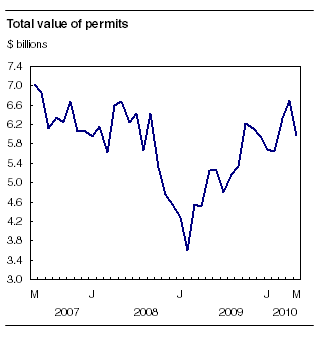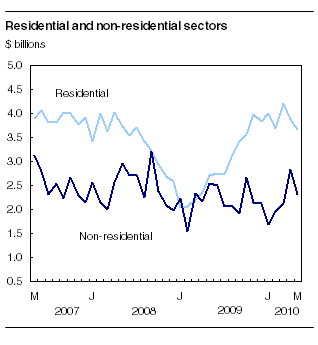This article was last updated on April 16, 2022
Canada: ![]() Oye! Times readers Get FREE $30 to spend on Amazon, Walmart…
Oye! Times readers Get FREE $30 to spend on Amazon, Walmart…
USA: ![]() Oye! Times readers Get FREE $30 to spend on Amazon, Walmart…
Oye! Times readers Get FREE $30 to spend on Amazon, Walmart…
Municipalities issued building permits worth $6.0 billion in May, a 10.8% decline from April. The decline follows two consecutive monthly increases. The value of permits in May was 13.9% higher than the level in May 2009.

Decreases occurred in both the residential and non-residential sectors. The value of residential permits fell 5.3% to $3.7 billion due to a decline in the single-family component.
After three months of increases, the value of non-residential permits fell 18.3% to $2.3 billion. The value of commercial and institutional permits decreased, while the value of industrial permits rose to its highest level since September 2008.
The value of permits increased in three provinces: British Columbia, Saskatchewan and Prince Edward Island.
Non-residential sector: Declines in the commercial and institutional components
In the commercial component, the value of permits fell 35.2% to $988 million in May following a 30.7% increase in April. Lower construction intentions were spread across a wide variety of buildings, such as office buildings, recreational, hotels and warehouses. Commercial building intentions fell in eight provinces.
Note to readers
Unless otherwise stated, this release presents seasonally adjusted data, which eases comparisons by removing the effects of seasonal variations.
The Building Permits Survey covers 2,400 municipalities representing 95% of the population. It provides an early indication of building activity.
The communities representing the other 5% of the population are very small, and their levels of building activity have little impact on the total.
The value of planned construction activities shown in this release excludes engineering projects (e.g., waterworks, sewers or culverts) and land.
For the purpose of this release, the census metropolitan area of Ottawa–Gatineau (Ontario/Quebec) is divided into two areas: Gatineau part and Ottawa part.
Revision
Preliminary data are provided for the current reference month. Revised data, based on late responses, are updated for the previous month.
The value of permits in the institutional component fell 21.6% to $690 million, halting three consecutive monthly increases. Lower construction intentions in educational, medical buildings and welfare homes contributed to this decline.
In the industrial component, the value of permits rose 47.1% to $644 million, the fifth monthly increase in a row. The gains came mostly from utility buildings in Ontario and manufacturing buildings in Quebec. Industrial construction intentions rose in eight provinces.
Residential sector: Intentions down for single-family permits
A marked decline in the value of permits for single dwellings brought down intentions in the residential sector in May.
Municipalities issued $2.3 billion worth of permits for single-family dwellings in May, down 9.2% from April. This was the second consecutive monthly decline following gains in the first three months of 2010. May’s decrease was due to lower construction intentions in seven provinces.
Following an 11.4% decline in April, the value of permits for multi-family dwellings increased 2.5% to $1.3 billion in May. This increase was mainly the result of higher construction intentions in Quebec, British Columbia and Saskatchewan.
Nationally, municipalities approved 17,124 new dwellings in May, down 4.4% from April. The decline was largely attribuable to single-family dwellings, which fell 6.5% to 8,168 units. The number of multi-family units approved declined 2.4% to 8,956.

Largest declines in Alberta, Ontario and Nova Scotia
The value of building permits fell in seven provinces in May.
The largest decreases occurred in Alberta, Ontario and Nova Scotia. In all three provinces, the decline was the result of lower intentions in the non-residential sector, which had posted strong gains in April.
British Columbia and Saskatchewan posted the largest gains in May, mainly the result of increases in institutional and multi-family permits. In Prince Edward Island, the increase came from the residential sector and the institutional component in the non-residential sector.
Value of permits down in more than half of the census metropolitan areas
The total value of permits fell in 18 of the 34 census metropolitan areas in May.
The largest declines were in Edmonton, Calgary and Windsor. In Edmonton, the decrease came mainly from the commercial component following a large increase in April. Calgary posted a decrease mainly in the single-family and the commercial component. In Windsor, the decline was attributable to all components in the non-residential sector.
The largest gains occurred in Montréal, Vancouver and St. Catharines–Niagara. In Montréal, the increase came mostly from multi-family and industrial permits. In Vancouver and St. Catharines–Niagara, the increase was due mainly to higher construction intentions in the non-residential institutional component.
You can publish this article on your website as long as you provide a link back to this page.

Be the first to comment